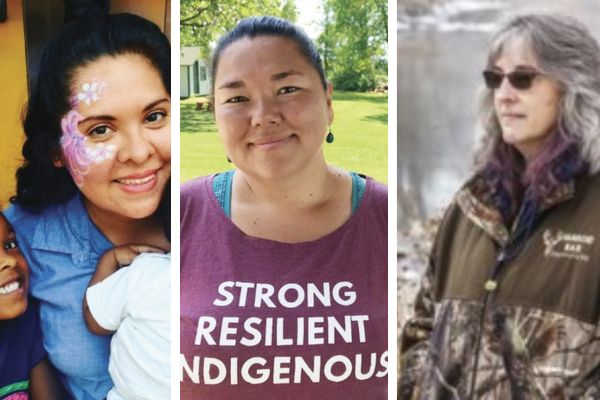
- Details
- By Minnesota Women’s Press
We Are Water MN is a traveling exhibit and community engagement program that explores the relationships Minnesotans have with water, created by the Minnesota Humanities Center, Minnesota Historical Society, Minnesota Pollution Control Agency (MPCA), and several environmental state agencies.
This article was originally published in the Minnesota Women’s Press.
According to Britt Gangeness, program coordinator for the MPCA, the group set out to learn and share how local people connect with water. Each year the exhibit travels to five host sites where new personal stories are gathered; thus far the programming has involved 28 communities.
The following are adapted from the original audio recordings for space and clarity.
Katya Zapeta
There is an African proverb that says: “A river that forgets its source runs dry.” That proverb has resonated with me. I am from Mexico City, but I have been a part of the Crookston community for over 25 years. When you come to the U.S. and Minnesota, this isn’t your home at the beginning. You get that thrown at you a lot: “Why are you here?” You start questioning yourself: “Who am I? What am I really doing here?”
My father instilled in me from a young age what I am and who I am — the many things Mexico has to offer, the beautiful and rich culture that is a part of me. Knowing the rich history that I come from has helped me deal with racism, standing strong knowing that I am someone of value. The Mississippi River is a reminder for me. It flows from the beautiful Itasca Park, where the river is born. One of the lessons I want to teach my children is to be proud of their roots, to not forget their source, and to take pride in being an American, because that also plays into how they are shaped.
Janie Domke, Hammond
We live half a block from the Zumbro River. If you’re a river person like me, that is the perfect place to live. My husband and I kayak the Zumbro every chance we get, all summer long. We actually got married on the river. We had been together 15 years by then. When I popped the question, he said, “I’m not going to wear a suit.” And I said, “Don’t worry. I’m not wearing a dress. We’ll just have a big canoe party wedding.”
So that’s what we did, on July 14, 2012. We had 15 boats that floated down the river with us.
In September 2010, the Zumbro River flooded from extensive rain. My partner had been at the bar we owned all night with people who could no longer get to their homes. The water wasn’t high enough to be in the bar yet, but it was covering the road. He locked up and came through the water. My husband is six feet tall, and it was chest deep. We [stayed with friends], just praying that our house would be saved, because we knew the bar would be a loss.
At first, you’re kind of numb. Being on the city council, I had to manage the city. The small town of Hammond lost tax revenue and became the owner of 17 properties that no one could build on.
Several people came up to us at our wedding and said, “I can’t believe that you got married on the river that destroyed your town.” I said, “Was it the river’s fault?” It’s part of nature.
Some people moved away because they were mad the river had done this to them. I am not one of those people. The river is the river. I’m not a victim. I’m a survivor.
Linda Black Elk, Onamia
I’m the ethnobotanist for the Mille Lacs Band of Ojibwe Department of Natural Resources. Ethnobotany is basically the relationship that people have with plants. I take that a step further, because I’m an indigenous woman, and I teach people how to use plants for food, medicine, and materials.
Because of our changing temperatures and our changing precipitation, we see the composition of Ojibwe forests changing. Elders remember amazing birch stands that were important for bark, sap, and medicinal buds that are no longer there.
If we’re going to survive — to bring water back to what it once was — we have to incorporate indigenous knowledge, because we have to incorporate the idea that water is living.
I can’t believe Western science is still so far behind that it doesn’t consider water to be alive.
To heal the water, we have to think of the water as a living being. In order to do that, we have to have indigenous science as the foundation of any revitalization efforts.
The traveling exhibit is at the Somali Museum of Minnesota until August 14, moving to Roseau through October 9 and Stillwater through December 4.
Help us defend tribal sovereignty.
At Native News Online, our mission is rooted in telling the stories that strengthen sovereignty and uplift Indigenous voices — not just at year’s end, but every single day.
Because of your generosity last year, we were able to keep our reporters on the ground in tribal communities, at national gatherings and in the halls of Congress — covering the issues that matter most to Indian Country: sovereignty, culture, education, health and economic opportunity.
That support sustained us through a tough year in 2025. Now, as we look to the year ahead, we need your help right now to ensure warrior journalism remains strong — reporting that defends tribal sovereignty, amplifies Native truth, and holds power accountable.
 The stakes couldn't be higher. Your support keeps Native voices heard, Native stories told and Native sovereignty defended.
The stakes couldn't be higher. Your support keeps Native voices heard, Native stories told and Native sovereignty defended.
Stand with Warrior Journalism today.
Levi Rickert (Potawatomi), Editor & Publisher

